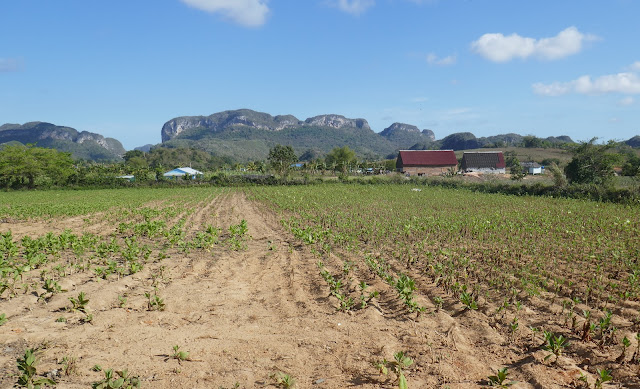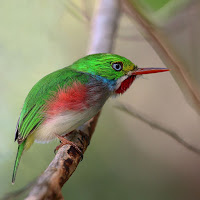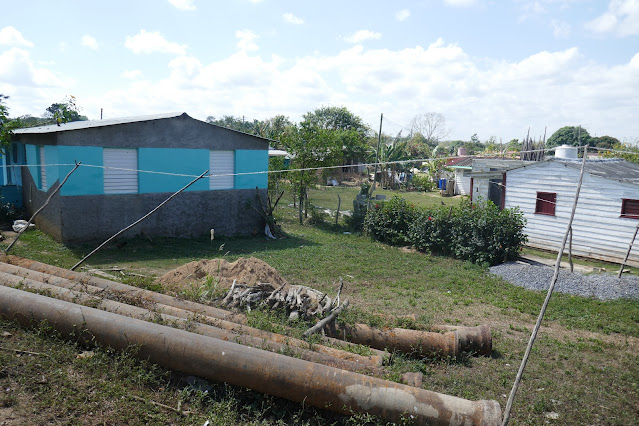Tobacco, Mogotes and a Jardin Botanico
Breakfast with Basita
 |
| Cuba |
Ham and cheese, often in sandwiches, are a Cuban staple. We encountered them frequently and both always came ready sliced from a plastic packet. Whether it is possible to find good ham and real cheese I do not know, but everything else Basita produced was fresh and top quality, so perhaps not.
 |
| Viñales is 20Km north of Pinar del Rio in the far West of the island |
Julio arrived at 9 o’clock for our walk round the valley – and we had plenty of breakfast to walk off. We stood outside the house as he showed us the intended route on his map.
 |
| Lynne on Basita's veranda in the early evening. In the morning we stood there with Julio |
Covid Related Alarms and Excursions
We were about to set off when Basita came bustling out and called us back for a phone call from Latin America Travel, the Cuban associates
of our British travels agents confusingly called Journey Latin America (JLA). The gist of the call was that we had an email from JLA
equiring an urgent response.
That alarm was followed by an excursion into town to the nearest bar with wifi; Julio said he would wait in the bookshop opposite the square. The bar was just opening and they switched on the wifi at our
request so we ordered a couple of espressos in return. The email
informed us that the earliest they could get us home was Saturday,
requiring a return to Havana on Friday. Unaware that the British
Government had warned against all but essential overseas travel and
advised citizens already abroad to return home, my reply was perhaps a
little gung-ho: we were booked to travel home on Tuesday, and that was
when we would like to go, or at least as close as possible.
The bookshop opposite the square was closed and Julio was nowhere to be seen. We were beginning to wonder how to fill our day when he
appeared carrying a heavy package which he deposited at the local travel
company’s office. ‘Are we still walking?’ he asked when we joined him.
We Eventually Start Walking
We walked back past Basita's and further down the rough road…
 |
| Past Basita's and further out of Viñales |
….eventually turning left into the countryside. A dusty track of red earth took us between fields, some fenced, some with hedges of cactus and other wild plants.
Tobacco and Cuban Cigars
Tobacco was the main crop and we soon arrived at a tobacco farm. Julio went to find the boss while we waited in the shade of an avocado tree…
 |
| Lynne not quite in the shade of an avocado tree, Viñales Valley |
…with a view over the tobacco fields to the mogotes (a less extreme version of the karst geology we have encountered elsewhere, particularly around Guilin in China and in Ha Long Bay in Vietnam).
 |
| Mogotes beyond a harvested tobacco field, Viñales Valley. |
Our host took us to the drying shed where the first part of this year’s crop was busy giving up its moisture.
 |
| Tobacco drying shed, Viñales Valley |
When the plants flower, he told us, the flowers are removed and the seeds become next year’s crop. Their removal encourages the leaves to
grow bigger and they are harvested in three parts; the top, middle
and bottom, are each used for different styles of cigars, the strongest
from the top and most delicately flavoured from the bottom.
In another shed he showed how, with only a flat surface and a sharp blade, it appears really easy to turn an unpromising bunch of leaves into a
cigar – though it is undoubtedly harder than it looks.
He started by stripping out the stalks ‘as that’s the most harmful part’ (and the rest is completely benign?)…
 |
| Stripping the stalks from the tobacco leaves, Viñales Valley |
…before selecting an outer leaf, cutting all but the eventual ‘wrapper’ into strips, laying them on the outer leaf and giving it a good roll. I had always believed that Cuban cigars were rolled on a maiden’s inner thigh - the truth was a tad disappointing.
 |
| Rolling the strips into a rough cigar |
He then carefully rolled the rough looking cigar into the wrapper leaf which was stuck into place. The result looked just like a cigar – until he held it up by the end.
 |
| Make your own joke |
After drying and packing it is ready for sale. Under the Cuban system the government takes a quota from the crop and the surplus can be sold
at market prices. Unfortunately for our host, we do not smoke and
declined to purchase any. He accepted this philosophically – he must
hear it often – and tentatively suggested we might take some home as
presents. Again we declined, we know very few smokers and none who smoke cigars.
 |
| Cigars for sale, Viñales Valley |
Horses, Bamboo and Birds
We took our leave and continued our walk through the fields.
 |
| Continuing through between the fields, Viñales Valley |
Passing a stand of bamboo, Julio made a comment about it being used for building in the far east, but it would never do in Cuba because of the
high winds. I could have mentioned typhoons, or the many, many other
uses of bamboo we have encountered, from guttering to gramophone needles, but if the Cubans have not worked it out for themselves….
 |
| Bamboo, Viñales Valley< |
Since we left the road, we had been continually passed from behind by riders in cowboy hats, some with a string of horses, all with a cheerful
‘Hola. ‘They have to go for a veterinary inspection today,’ Julio explained.
Eventually we reached the farm where the inspections were taking place.
After that the horses were coming towards us.
 |
| Horses on the way to vetinary inspection, Viñales Valley |
We followed Julio as the land gently rose…
 |
| Following Julio as the land rose |
…until we had a view over Viñales town…
 |
| Viñales |
…. and to the nearest mogote, small and detached from the main group, it is known as Coco Solo.
 |
| Coco Solo, Viñales Valley |
 |
| Cuban Grassquit |
 |
| Cuban Tody |
(Tody by Charles J Sharp, reproduced under Creative Commons Attribution Share-Alike 4.0 International, Grassquit by Richard Taylor, reproduced under Creative Commons Attribution 2.0 Generic)
Cuban Fruit and Coffee
We reached a café across the dam of a partly empty reservoir…
 |
| A dam and a partially empty reservoir, Viñales Valley |
…with a view good of the larger slightly more distant mogotes.
 |
| Mogotes, Viñales Valley |
After a short wait we were introduced to Reuben from the nearby farm who gave us a tour of his fruit trees, including cocoa which
may not be a fruit…
 |
| Cocoa, Viñales Valley |
…and pineapple which is not a tree.
 |
| Pineapple, Viñales Valley |
We had never heard of mamey, but Reuben assured us it is the best fruit in Cuba, ‘even better than mango’. There are (I have learned)
two unrelated fruit called mamey, the yellow mamey or South American apricot (mammea
americana) and the red mamey (pouteria sapota) which is common in
Cuba and southern Florida. I presume, therefore, that this is red mamey, though
the colour only becomes evident when they are cut open.
 |
| Mamey, Viñales Valley |
We have heard of maracas, but not heard of them growing on a tree. The fruits below are one of four closely related Crescentia
fruits. The pulp is not good to eat, but rural Cubans traditionally used the hard
shells as bowls or coffee cups, or just dry them with the seeds inside as maracas.
 |
| Maracas Tree, Viñales Valley |
Coffee is Reuben’s main crop and he introduced us to the surplus they are allowed to sell after the government has taken its quota. Cuban
coffee is good and strong, so we bought a bottle of beans. We also tasted
Guayabita de Pinar, rum flavoured with small (blueberry sized) guavas, a
speciality of Pinar del Rio Province. It was very pleasant, but our 2 litre duty-free
allowance was already earmarked for Havana Club 3 year-old, the perfect rum for
cocktails, and Havana Club 7-year-old, the most sumptuous of rums, so he made
no sale.
 |
| Coffee and Guayabita del Pinar, Viñales Valley |
Past Coco Solo and Back to Basita’s
Leaving Reuben we walked past a market garden.
 |
| Market Garden, Viñales Valley |
Somewhere after the tobacco farm we had found our way round the back of Coco Solo (insofar as a mogote has a ‘front’ and ‘back’) and
now approached it from the ‘far’ side.
 |
| Coco Solo, Viñales Valley |
Tracking round the end of the mogote …
 |
| Coco Solo, Viñales Valley |
…we reached what appeared to be a remote hamlet. Aerial photos suggest it is more the last gasp of Viñales’ straggle into its rural
hinterland, but it felt like a different, remoter world.
 |
| Rural hamlet by Coco Colo, Viñales Valley |
From here we followed the track back to the road past Basita’s. It was well past midday, we had set out in the morning warmth, but the day had become far hotter than is ideal for walking. Julio complained of the
heat and asked how we were coping. We may not be so used to it – though we are
hardly inexperienced – but I felt comfortable in Viñales, my shoes and socks
stained red with the dust that formed a light coating on all exposed skin, and a temperature
nudging 30°. It felt a better option than 10° and drizzle in north
Staffordshire.
Lunch in Viñales
We said ‘farewell’ to Julio, washed off as much of the
dust as was willing to go quickly and walked into town to find some lunch.
Picking a restaurant with free wifi, but otherwise rather at random we found the beer was a little more expensive but came with a ‘free’
tapa (not a word often used in the singular in this context). We ordered cheese
and ham toasties, too, to be on the safe side. The tapa was patatas bravas, and
small enough to be just right with the toastie. Many years ago, when I was nowt
but a puppy, a wise older man whose name I have long forgotten told me there
was no such thing as bad beer, there is just beer and good beer. Cuban beer,
whether Bucanero or Cristal is beer, but it was cold and wet and did its job.
Lunch over; we walked down to the Botanical Gardens.
Botanical Gardens, Viñales
As botanical gardens go, Viñales’ garden is small but perfectly formed. Created by sisters Caridad and Carmen Miranda whose family
still live on site, it is free (donations are requested) and volunteer guides
greet visitors at the gate.
Perhaps the best description of the garden is ‘controlled jungle’ with quirky humour; the odd rag doll appears in the foliage, the ‘beer
tree’ is bowed down with cans and bottles, and another tree fruits hard hats.
 |
| Hard hat tree, Viñales botanical gardens |
My botanical knowledge is weak and we were shown many more plants than I can remember, but here are a few that stuck in my mind.
Plants we normally see growing in pots indoors, like the spider plant…
 |
| Spider palnt, Viñales botanical garden |
…or the Swiss cheese plant are happy outdoors here.
 |
| Swiss cheese palnt, Viñales botanical gardens |
There is even a parasitic Swiss cheese plant.
 |
| Parasitic Swiss cheese plant |
The Ceiba (Kapok) tree was spiritually important to the now wiped out indigenous Cubans, and still is to the Mayans. The founding
of Havana was completed under the shade of a Ceiba where
the Templete now stands.
 |
| Ceiba tree, Viñales botanical gardens |
The Cuban national tree, the Royal Palm (Roystonea Regia), is a particularly tall ornamental palm….
 |
| Royal palm, Viñales botanical garden |
…and the path beneath the palm was strewn with the flowers of the shaving brush tree (Pseudobombax ellipticum).
 |
| The flower of the shaving brush tree, Viñales botanical gardens |
At the end another guide gave a brief talk about their fruit trees and pressed slices of pineapple and starfruit on us. I am not
a big fan of starfruit but the pineapple was ripe and sweet.
 |
| Fruit at the Viñales Botanical Garden |
We then repaired to the little café among the trees to check Reuben’s claim this morning that mamey juice was better than mango. It
was reddish, sharpish and thin – mango has nothing to fear.
Back to Basita's
The
road to Basita’s is always of interest. We saw no horse-drawn vehicles in
Havana, but they abound here, and the old American cars are not for show.
 |
| Driving in Viñales - believe it or not, Cubans drive on the right! (in theory) |
We thought we might spend an hour sitting on the veranda with a book, but as soon as we arrived Basita plied us with coffee and biscuits and a huge pile of fruit. Resistance was futile.
When we did reach the veranda we had another visit from the little lad next door with his large knife and even lager scabbard. He ran through his ninja moves
and showed how sharp the knife was by slashing at the long grass. Do his
parents know he is playing with that knife?
Diner in Viñales
Later we walked into town and ordered daiquiris at the garden restaurant where we drank mojitos yesterday. Their wifi told us there
was no news on the flight front, and their menu suggested we might like ropa
vieja, literally ‘old clothes’. Ropa vieja, generally popular around the Spanish
speaking Caribbean, is one of Cuba’s national dishes. We had to give it a go.
Usually it involves beef being stewed to extreme tenderness and then pulled apart. The sauce is tomato based with onions,
peppers, garlic and vinegar and the accompaniment is rice, beans and fried
plantains. This was pork rather beef and the beans were missing but otherwise it
was fairly typical, I think. We liked it, though it was more comfort food than
ground-breaking - but that is the way with Cuban cuisine.
 |
| Ropa Vieja, Viñales. Normally I would not recommend drinking beer and cocktails at the same time, but this is Cuba |
We had finished eating when four German couples arrived requiring tables to be pulled together. We generously donated ours and had a
final cocktail in the more informal seating area.
 |
| Sometimes the stress of it all starts to grind me down |
Then we ambled slowly ‘home’ in the balmy warmth of the tropical evening.
Part 1: Havana
Part 2: Havana to Viñales
Part 3: Walking the Viñales Valley
Part 4: Viñales to Trinidad de Cuba
Part 5: Trinidad (1) The Town
Part 6: Trinidad (2) Valle de Los Ingenios
Part 7: Santa Clara and Che Guevara
Part 8: Jibacoa and a Strange Trip Home





















